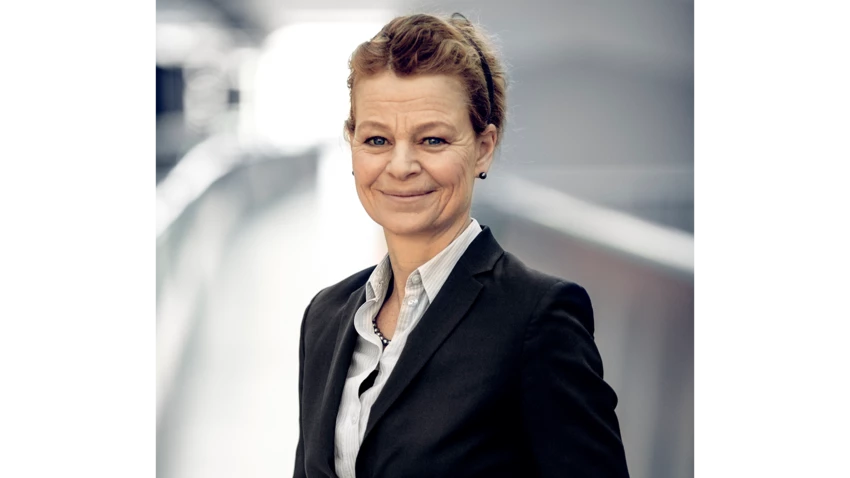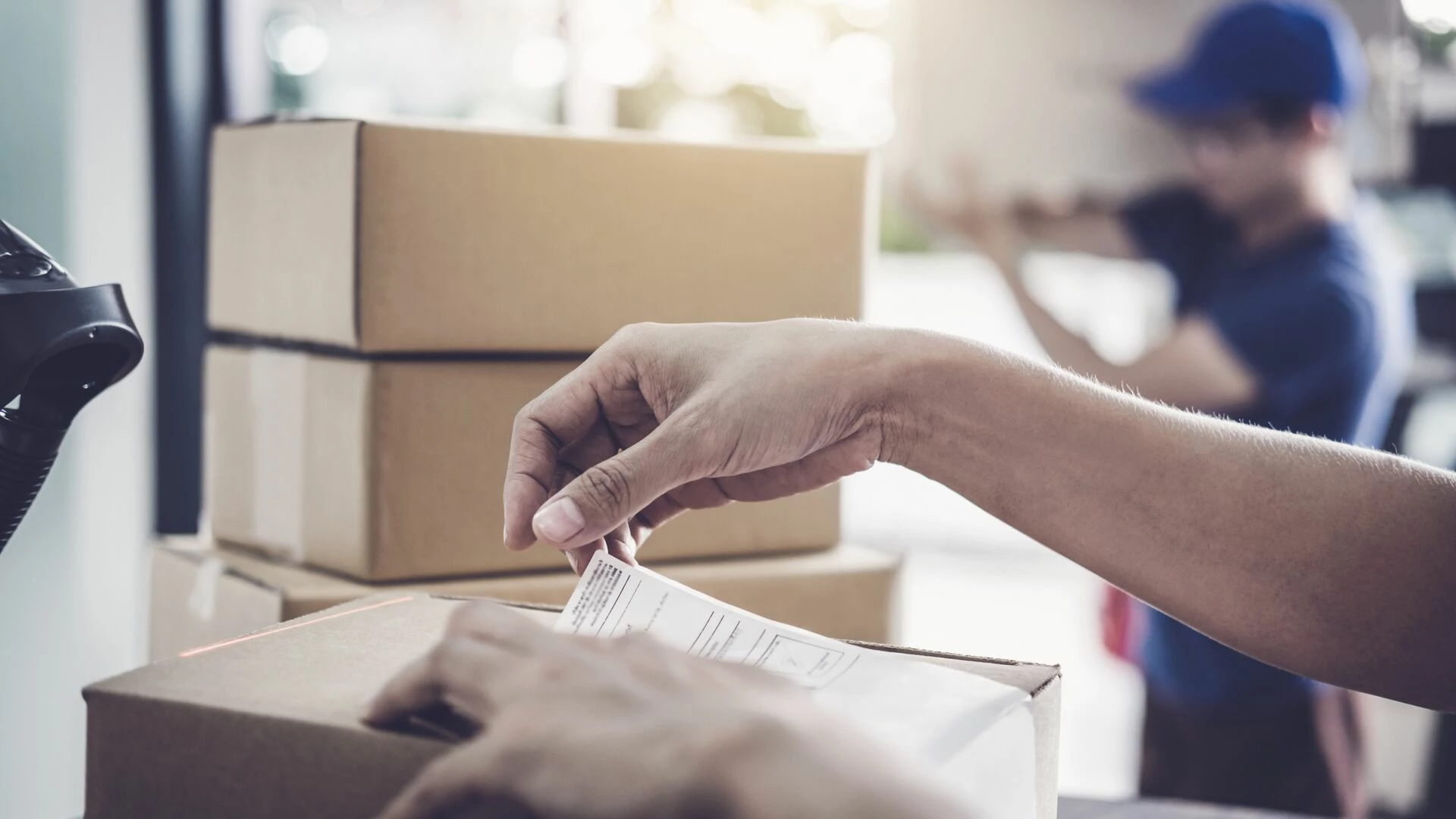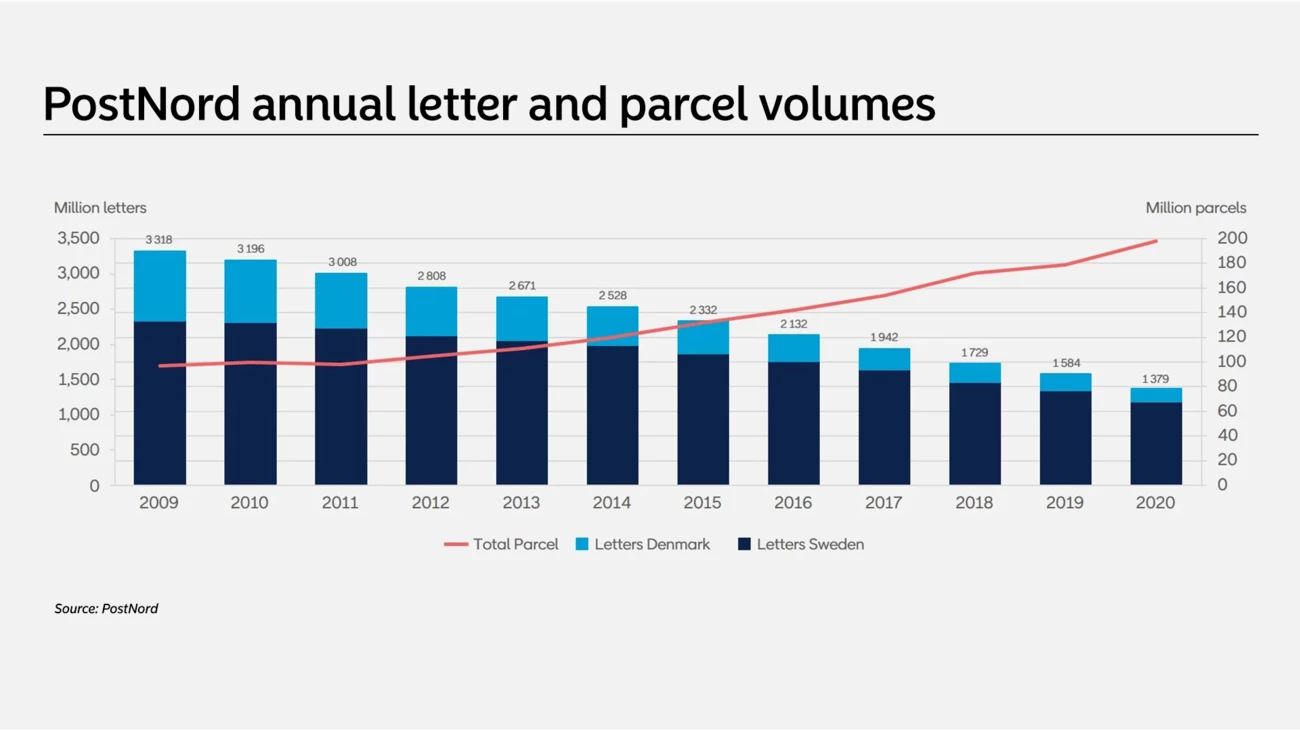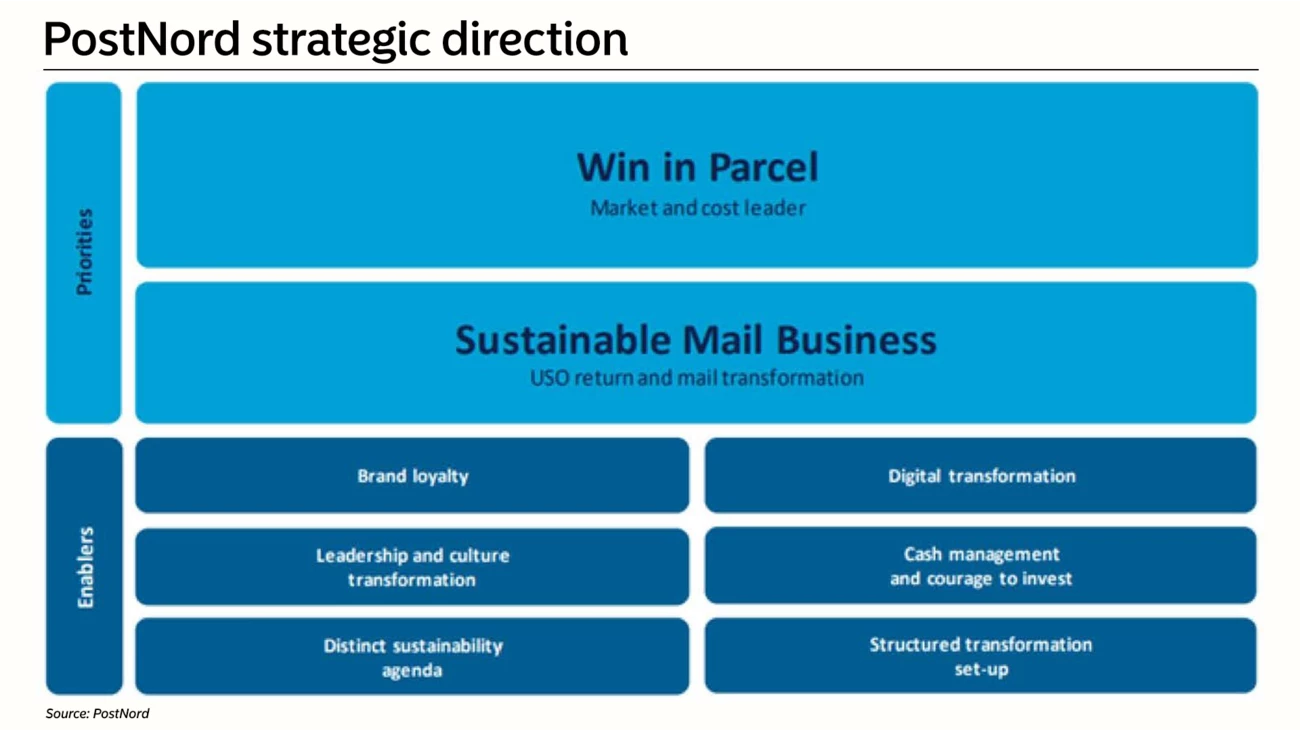
Annemarie Gardshol
Group CEO and President of PostNord
Sivua ei ole saatavilla suomeksi
Pysy sivulla | Siirry aiheeseen liittyvälle suomenkieliselle sivulleCoping with explosive parcel volume growth during the pandemic was a challenge for postal services provider PostNord. Having scale was helpful. PostNord CEO Annemarie Gardshol shares the experience and gives us the fulfilment logistics perspective on e-commerce.

The pandemic boost to e-commerce growth is over, but it has accelerated online retail migration by 1-2 years. PostNord is investing to accommodate more growth, with a clear commitment to have a sustainable business with fossil-free transport by 2030, CEO Annemarie Gardshol (AG) tells Nordea's Johan Trocmé in this interview from Nordea On Your Mind: E-commerce - The new normal.
JT: You must have undergone one of the most dramatic business transformations in modern history over the past 10-15 years; how would you briefly describe PostNord's business today?
AG: Indeed, PostNord has undergone an immense transformation in the past decade, and we continue to adapt and develop our business. This is, of course, due to digitalisation and changes in how people communicate and shop – e-commerce has increased, and letter volumes have declined. To illustrate: between 2011 and 2021, letter volumes in Sweden and Denmark dropped from around 3 to 1.2 billion. During the same period, parcel volumes increased from 98 to 226 million. This is our future and the reason why PostNord works systematically to enable world-class e-commerce in the Nordic region.
Today, PostNord is a leading provider of parcel and logistics services to, from and within the Nordic region. Our vision is to be the favourite carrier of the Nordics and our purpose is to make everyday life easier – for consumers, customers and colleagues. PostNord connects businesses, public authorities and households, and makes business, trading and communication possible across the Nordic region.
By offering common products and services, the most extensive distribution network in the Nordic countries, as well as a wide range of flexible delivery options for receivers to choose from, we bring e-retailers and consumers closer together. In parallel, we continue to adapt our mail business as letter volume declines.

Group CEO and President of PostNord

JT: How are you positioned to offer e-commerce fulfilment compared with new logistics players? Can you benefit from your legacy platforms in any way? Are there any capabilities you lack and would like to develop or acquire?
AG: PostNord has a leading position in the Nordic logistics market, thanks to an extensive network of both geographic and collaborative partnerships. Our size allows us to benefit from economies of scale, and with 26 parcel terminals and 8,000 distribution points, we have the potential for continued future growth. One area of investment is the growing parcel locker segment. We now have more than 7,000 parcel lockers in the Nordic region; we aim for 12,500 by the end of the year, and even more beyond 2022.
Parcel lockers is a growth area; PostNord has over 7,000 lockers in the Nordics and aims for 12,500 by the end of the year.
To further boost PostNord’s position, we continually study how our customers’ businesses transform, and what the supply chain consequences will be. Based on these insights, we reengineer and adapt our product portfolio and network solutions so that we can provide relevant end-to-end offerings. We constantly look for different ways to strengthen our offer, including retooling and optimising operations to get more out of existing terminals and networks, investing in new infrastructure and technology, advancing our innovation and business development, and by making acquisitions.
By analysing changes in logistic flows, we can smartly utilise our capabilities and increase the transport effectiveness in our logistics system. Such changes have capacity, cost and sustainability effects. PostNord’s history and foundation is a strength and accelerates our ongoing transformation of processes and platforms. We build on our employees’ competence and business knowledge, finetuned processes and the vast amount of data that we have.
Scale is important for e-commerce fulfilment, especially in urban areas, and for creating the ability to cope with volume fluctuations.
JT: How important is scale for e-commerce fulfilment? Logistics network coverage versus platform and systems? International versus regional versus last mile?
AG: Scale is important for e-commerce fulfilment. Large-scale logistics operators can achieve both fast and sustainable deliveries at a low cost that allows for competitive value for money pricing. This is especially true in urban areas. Our extensive network and wide range of services also makes it possible to serve receivers in sparsely populated areas, where we can leverage synergies in the last-mile deliveries. Finally, being a large-scale operator means that we can adapt to volume fluctuations. These attributes are necessary to enable e-commerce retailers to succeed in their highly competitive industry.
More retailers are also looking for solutions that allow them to easily relocate stock from one fulfilment centre to another, both domestically and internationally. The purpose is to expand geographical reach and fulfil orders more locally, and ultimately to achieve fast, sustainable and cost-effective deliveries. This is especially attractive for smaller to medium-sized retailers who cannot easily do this themselves. They may even want to outsource this completely to their e-commerce fulfilment provider, and this is also an area where we can play a role for our customers.

JT: Is there a sustainability challenge in e-commerce compared with traditional retail? What are your ambitions in sustainability?
AG: It is not entirely easy to evaluate physical versus online retail – environmental and social performance depends on how it is carried out. Generally speaking, e-commerce shares some sustainability challenges with traditional retail, and also has its own challenges. When it comes to environment and climate, return flows is one such challenge. PostNord addresses this challenge in several ways; for instance, we work with our customers to reduce the amount of air in parcels. I would also like to point out that we enable consumer-to-consumer second-hand shopping, which entails lower carbon emissions.
PostNord targets fossil-free transport by 2030, a 40% reduced total carbon footprint in 2025 versus 2020 and emission-free last-mile transports in the Nordics no later than 2027.
PostNord has introduced an ambitious agenda to drive a sustainable transition in the entire transport sector. Our ambition is to be the leading operator when the mail and logistics industry steps into the low-carbon economy.
PostNord’s agenda for sustainable logistics includes commitments within three areas: climate leadership, people and diversity. More precisely, we aim for fossil-free logistics, a zero-vision for safety, fair terms and an inclusive workplace. When it comes to climate leadership, Green by PostNord is our main program. Via Green by PostNord, we are taking the lead in securing a Nordic infrastructure for fossil-free transport by 2030 for the more than 13,000 vehicles that we and our partners operate in the Nordics. Green by PostNord includes a half-way target – to reduce our total carbon footprint by 40 percent in 2025 compared to 2020. Another important target is to achieve emission-free last-mile transports throughout the Nordic region no later than 2027.
As of April, PostNord’s plan to reduce our overall climate footprint is endorsed by the Science Based Targets initiative, meaning that we are working in line with the Paris Agreement to keep global warming below 1.5°C. PostNord is a signatory of the UN Global Compact, and our sustainability agenda is linked to the Sustainable Development Goals.
Finally, I would like to mention a recent confirmation that our sustainability efforts are on the right track: The Financial Times and Statista named PostNord as one of Europe’s Climate Leaders. Their list consists of the 400 European companies that achieved the biggest reduction in carbon dioxide density between 2015 and 2020.
The explosive parcel volume growth during the pandemic was managed by "sweating" assets in smart ways with proven technologies and processes.
JT: How did you cope with the explosive growth in parcel volumes during the COVID pandemic? Would you be able to accommodate any new 'demand shock' going forward? Do you think consumer behaviour has changed permanently, or could e-commerce go back to pre-COVID patterns again?
AG: Given PostNord’s commitment to the societies we serve, upholding operations in times of crisis was very important. The safety of employees and customers came first, and by protecting them, we were able to keep our operations going.
To cope with the explosive growth in parcel volumes during the pandemic, PostNord focused on "sweating" our existing assets in smart and efficient ways, rather than relying on traditional terminal expansions. This involved investigating and implementing new but proven technologies and processes to increase the utilisation and efficiency of terminals, vehicles and personnel. This is an ongoing effort even today, after the explosive growth during the pandemic. Our response during the pandemic is proof of the vast competence of our people and shows that PostNord is able to handle both ups and downs in demand. We are constantly becoming more flexible, and today we are even more capable than before COVID-19.
Primarily, two consumer behaviours changed during the pandemic. Firstly, there was a shift in delivery channel preference towards parcel lockers and home deliveries, particularly unattended. This was a result of people’s desire to avoid physical contact as well as greater market supply as new start-up entrants leveraged this shift to grow rapidly. It seems that this shift is here to stay, and we expect it to accelerate further. Secondly, there was a rapid acceleration in the online share of total retail – existing online shoppers increased their purchases and more people began shopping online. This shift slowed down when physical shopping without restrictions became possible. However, it has not gone back to pre-pandemic levels.
Even given the slowdown this year, the pandemic accelerated the shift to online shopping by 1-2 years. Growth in 2022 is low compared to 2021 but should return to pre-pandemic year-on-year growth. However, given the current geopolitical and macroeconomic situation, consumption is likely to decrease and it remains to be seen how much e-commerce will be affected. In the longer term, we believe that e-commerce will grow, and we invest accordingly.
All in all, we handled the sharp increase in parcel volumes during the pandemic well. Currently, we are adapting production capacity to current parcel volumes and continuing to invest to further strengthen PostNord’s position in the long-term growing e-commerce market.
Did the Covid-19 pandemic have a lasting impact on the growth of e-commerce and the online migration of retail sales? Will the trend continue? Below you find all the latest publications from the Nordea On Your Mind report "E-commerce - The new normal".
Explore all publications from Nordea On Your Mind here.

Sustainability
Amid geopolitical tensions and fractured global cooperation, Nordic companies are not retreating from their climate ambitions. Our Equities ESG Research team’s annual review shows stronger commitments and measurable progress on emissions reductions.
Read more
Sector insights
As Europe shifts towards strategic autonomy in critical resources, Nordic companies are uniquely positioned to lead. Learn how Nordic companies stand to gain in this new era of managed openness and resource security.
Read more
Open banking
The financial industry is right now in the middle of a paradigm shift as real-time payments become the norm rather than the exception. At the heart of this transformation are banking APIs (application programming interfaces) that enable instant, secure and programmable money movement.
Read more